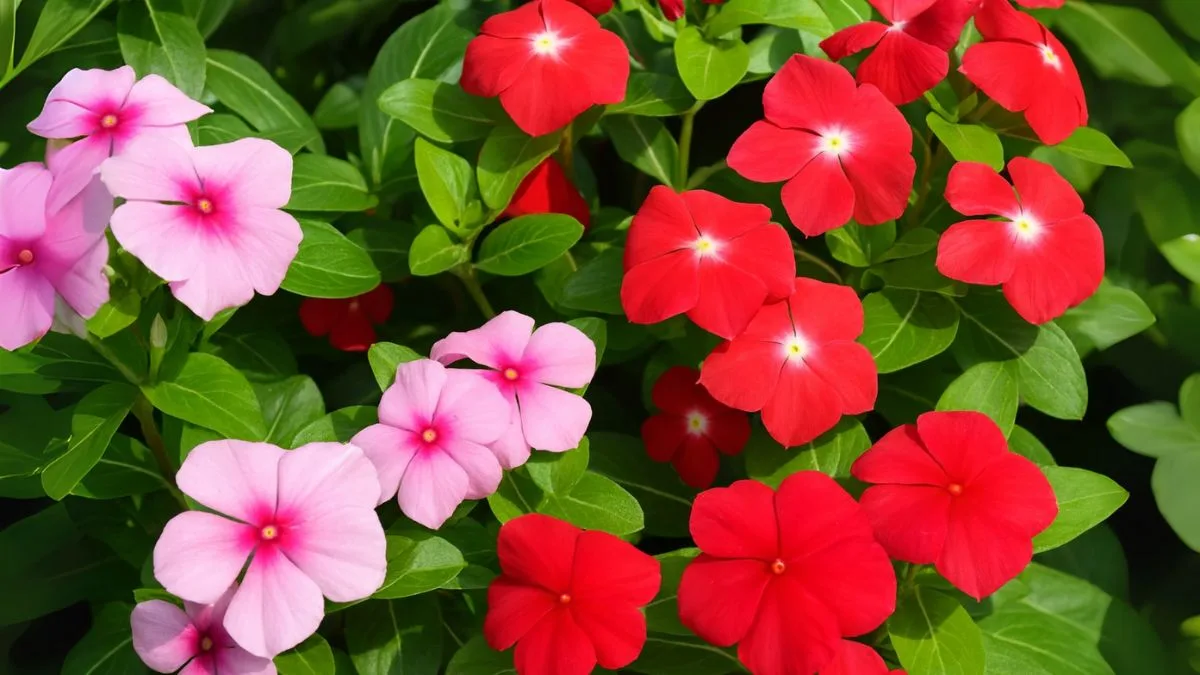If you’ve ever admired a carpet of delicate flowers brightening up a garden or walkway, chances are you’ve seen the periwinkle. This humble plant may not grab headlines like roses or lilies, but it holds its ground as one of the most adaptable and rewarding plants worldwide, from Canada and the USA to tropical regions.
Types of Periwinkle

Periwinkle comes in a variety of species, each with its own charm:
1. Madagascar Periwinkle (Catharanthus roseus)
- Known for its glossy leaves and pink, white, or red flowers.
- Popular in both ornamental gardening and herbal medicine.
2. Common Periwinkle (Vinca minor)
- A ground cover favorite that grows about 6 inches tall.
- Blooms in shades of blue, purple, and white, creating lush floral carpets.
3.Greater Periwinkle (Vinca major)
- Larger leaves and flowers compared to Vinca minor.
- Excellent for slopes, walls, or covering wider garden spaces.
Each type adds unique character, whether you’re aiming for vibrant flower beds or low-maintenance greenery.
Also Read: Plant These in Spring for a Garden Bursting with Color and Fragrance
Care Tips for Periwinkle
- Sunlight and Shade: The best part about periwinkle is its flexibility. It thrives in areas with partial shade to full sun. In fact, it can grow well in both sun and shade, making it a perfect choice for beginners who are still experimenting with plant placements.
- Soil and Planting: Always plant with the top of the rootball level with the ground. Periwinkle does well in loamy, well-drained soil. Adding compost will give the plants an extra nutrient boost.
- Watering: While young plants need consistent watering, mature periwinkles become drought-tolerant. If you’re gardening in rainy regions, you’ll be glad to know it is suitable for raising as a rainfed crop.
- Maintenance: Minimal care is needed—just prune occasionally to prevent overgrowth. It’s also relatively resistant to pests and diseases.
Propagation of Periwinkle
One reason gardeners adore periwinkle is how easily it spreads. You have multiple options:
- Seeds: Propagation is through seeds sown directly or in a nursery, and through cuttings. Start seeds indoors or scatter them outdoors in spring. Within weeks, tiny seedlings begin to sprout.
- Cuttings: For a quicker method, use stem cuttings. Simply snip a healthy shoot and plant it in moist soil. Gardeners also easily make cuttings via layering, where stems in contact with soil naturally develop roots.
- Layering: This method works wonders for periwinkle ground cover. Bend a low branch to the soil, cover it lightly, and roots will form in a few weeks. Once established, separate the new plant and replant elsewhere.
Why Gardeners Love Periwinkle
Feature |
Benefit |
Adaptability |
Can grow well in both sun and shade |
Growth Habit |
Grows about 6 inches tall, perfect for borders |
Water Needs |
Suitable for raising as a rainfed crop |
Propagation |
Flexible—seeds, cuttings, or layering |
Aesthetic |
Year-round greenery and seasonal flowers |
From my own gardening experience, periwinkle was one of the first plants I grew as a beginner. Its forgiving nature boosted my confidence. Even when I forgot to water it during a busy week, it bounced back with fresh blooms.
Also Read: The Morning Glory Plant: A Morning Mystique
Personal Experience with Periwinkle
When I first introduced periwinkle into my Canadian garden, I wasn’t sure it would adapt to the varying climate. To my surprise, the plant flourished—whether in sunny spots by the fence or shaded corners under trees. Its ability to thrive in areas with partial shade to full sun made it the perfect filler plant, adding color where other flowers struggled.
I also experimented with propagation. Using the cuttings via layering method, I was able to cover a bare patch of soil within a season. It truly lived up to its reputation as a resilient, low-maintenance plant.
Conclusion
The periwinkle is a gardener’s dream—hardy, beautiful, and versatile. With its ability to grow about 6 inches tall, adapt to different light conditions, and spread easily, it’s ideal for beginners and experts alike. From propagation through seeds, cuttings, or layering to its suitability as a rainfed crop, this plant proves it belongs in every garden.
If you want a plant that requires little yet gives a lot—adding charm, greenery, and resilience—periwinkle is your go-to. Start with a small patch, and soon you’ll see why this humble flower has earned global love.






